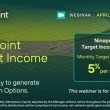by Chris Konstantinos CFA®, Managing Partner, Chief Investment Strategist, Riverfront Investment Group
What History Can Tell Us About Seasonal Returns
SUMMARY
- September and October historically have been difficult months for the market.
- However, markets tend to rally in the winter, especially in election years.
- Riverfront remains positive on the fundamental and technical backdrop for stocks.
Buckle your seatbelts…we are now past Labor Day and thus ‘the witching season’ starts. No, not Halloween…but rather the spooky market anomaly that is September. According to a NDR Research study of 656 months starting in December 1969, September has been historically the worst month of the year in terms of stock market returns. This is true both in terms of percentage of positive outcomes (September is positive only 44% of the time - red bar in Chart 1, below) and in average return, as September is the only month of the year that averages a negative return. Adding insult to injury, October also tends to be a volatile month that witnesses the most market lows.

This autumn, the market fear du jour concerns the perception of rising recession risk…albeit with a few election-year twists. Recent lackluster employment and manufacturing data have caused 10-year Treasury bond yields and the price of oil to break to new yearly lows, stoking recession fears. Despite this, we offer three good reasons NOT to sell now:
First, the ‘witching season’ tends to give way to ‘Santa Claus’ rallies: November and December tend to be two of the strongest stock market months of the year in terms of both average return and probability of positive return (green bars in chart). In an election year, this effect can be pronounced: a market rally into the end of the year is typical after an election result becomes clear…regardless of which party wins. Furthermore, we believe the first year of a new Presidential cycle also tends to feature strong stock markets, suggesting a seasonal tailwind for investors through 2025.
Second, trying to trade selloffs in secular bull markets is difficult and can disrupt a long-term financial plan. Timing market bottoms is difficult to consistently do well, as bottoms often are only ‘obvious’ in hindsight. In our view, long-term damage has been done by some investors who have exited markets, convincing themselves they will reinvest ‘when things get better’…but in reality, often don’t. We are a dynamic asset manager who may undertake meaningful risk reduction when it’s deemed necessary. Importantly, we also concurrently formulate a reinvestment strategy, which can help keep an investor’s long-term financial plan in place.
Third, Riverfront remains positive on economic and market fundamentals. The equity market rally has been predicated on a ‘Goldilocks’ scenario of continued growth in the economy and corporate earnings, even as the Fed starts cutting interest rates. This is borne out in the recent economic data, in our view. The Atlanta Fed’s GDPNow tracker is currently trending at around 2.3% real GDP growth for Q3, after a strong 3% print for Q2. Corporate profit and cash flow levels also just hit an all-time high in Q2, keeping credit spreads contained and lending availability favorable. As discussed here, we continue to believe the US economy is not on the brink of recession.
Technical Outlook Remains Favorable; Some Levels We Are Watching
The study of technical price movements provides another objective, sometimes contrary view, offering a useful supplement to fundamental analysis. Today, we see the technical picture as confirming our positive fundamental view. The overall trend remains positive, with an upward-sloping 200-day moving average (green line, Chart 2 left). The S&P 500 has been stalling just below its July 16th record high of 5667 since mid-August. An upside breakout above 5667 would be a positive signal that the S&P is on track to hit 6,000 by year end, in our view. That said, we expect some time and consolidation in order to get through September’s ‘witching season,’ with the previous high acting as potential resistance this fall.

Should the market fail here to make new highs, we see initial support levels around 5300, which is the 23% retracement of the rally from last October’s low. We view 5071 (the 38% retracement) as the secondary support level. Even a pullback to 5000 would be consistent with a typical ‘routine’ pullback within the context of a healthy secular bull market, in our opinion. Additionally, Riverfront’s proprietary analysis of historical probabilities is currently giving an above-average chance of market gains over the next 3 months.
Risk Discussion: All investments in securities, including the strategies discussed above, include a risk of loss of principal (invested amount) and any profits that have not been realized. Markets fluctuate substantially over time, and have experienced increased volatility in recent years due to global and domestic economic events. Performance of any investment is not guaranteed. In a rising interest rate environment, the value of fixed-income securities generally declines. Diversification does not guarantee a profit or protect against a loss. Investments in international and emerging markets securities include exposure to risks such as currency fluctuations, foreign taxes and regulations, and the potential for illiquid markets and political instability. Please see the end of this publication for more disclosures.
Copyright © Riverfront Investment Group















